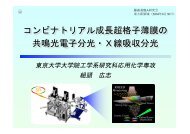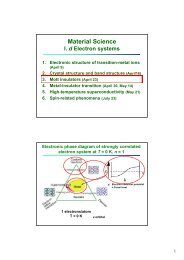Thesis High-Resolution Photoemission Study of Kondo Insulators ...
Thesis High-Resolution Photoemission Study of Kondo Insulators ...
Thesis High-Resolution Photoemission Study of Kondo Insulators ...
You also want an ePaper? Increase the reach of your titles
YUMPU automatically turns print PDFs into web optimized ePapers that Google loves.
64 Chapter 5. Temperature Dependence <strong>of</strong> the <strong>High</strong>-<strong>Resolution</strong> <strong>Photoemission</strong> ...<br />
the f states by photoemission spectroscopy (PES). Actually the peculiar temperature<br />
dependence <strong>of</strong> the 4f emission in Yb compounds has been studied extensively with<br />
high-resolution PES [5.3]. However, few PES studies have so far focused on the non-f<br />
conduction-band states. Schlesinger et al. remarked on the optical spectra <strong>of</strong> a “3d<br />
<strong>Kondo</strong> insulator” FeSi [5.4] that the entire conduction band, which screens all the local<br />
moments, could depend on the temperature. Such a temperature dependence could<br />
appear in the formation <strong>of</strong> the <strong>Kondo</strong> singlet irrespective <strong>of</strong> whether the system becomes<br />
a renormalized metal or insulator. The electrical resistivity <strong>of</strong> the <strong>Kondo</strong> insulator<br />
is expected to be dominated by the <strong>Kondo</strong> effect at high temperatures and to show<br />
activated behavior at low temperatures. Thus a significant temperature dependence<br />
is expected in the conduction-band states and such a temperature dependence may<br />
give a clue to understand the <strong>Kondo</strong> insulators. In the preceding work using YbB12<br />
polycrystals, we have studied the low-temperature electronic structure [5.5] and its<br />
Lu-substitution effects [5.6] by PES. For the conduction-band states <strong>of</strong> B 2sp -Yb5d<br />
hybridized character, we have found that a broad dip or a pseudogap <strong>of</strong> ∼ 40 meV width<br />
is present and is filled gradually with Lu substitution. YbB12 has a cubic UB12-type<br />
structure [5.7] and is believed to develop a rather isotropic gap at low temperatures.<br />
In this work, we have made a PES study <strong>of</strong> YbB12 single crystals with higher energy<br />
resolution to investigate how the (pseudo)gap evolves as a function <strong>of</strong> temperature.<br />
5.2 Experimental<br />
Single crystalline YbB12 samples were prepared using the traveling-solvent floating-zone<br />
method [5.8]. YbB12 forms by a peritectic reaction at 2200◦C, which temperature is close<br />
to the peritectic temperature <strong>of</strong> the adjacent phase YbB66 (2150◦C)[5.9]. In order to<br />
keep the temperature inhomogeneity less than 50 ◦ C at 2200 ◦ C we used an image furnace<br />
with four xenon lamps. Laue photographs and x-ray powder diffraction confirmed large<br />
samples to be single crystalline. Figure 5.1 shows the electrical resistivity and the<br />
magnetic susceptibility <strong>of</strong> the best rod grown in this way [5.8]. The resistivity increases<br />
monotonously by more than five orders <strong>of</strong> magnitude as the temperature is decreased<br />
from 300 K to 1.3 K. The activation energy (∆act) for 15 K






